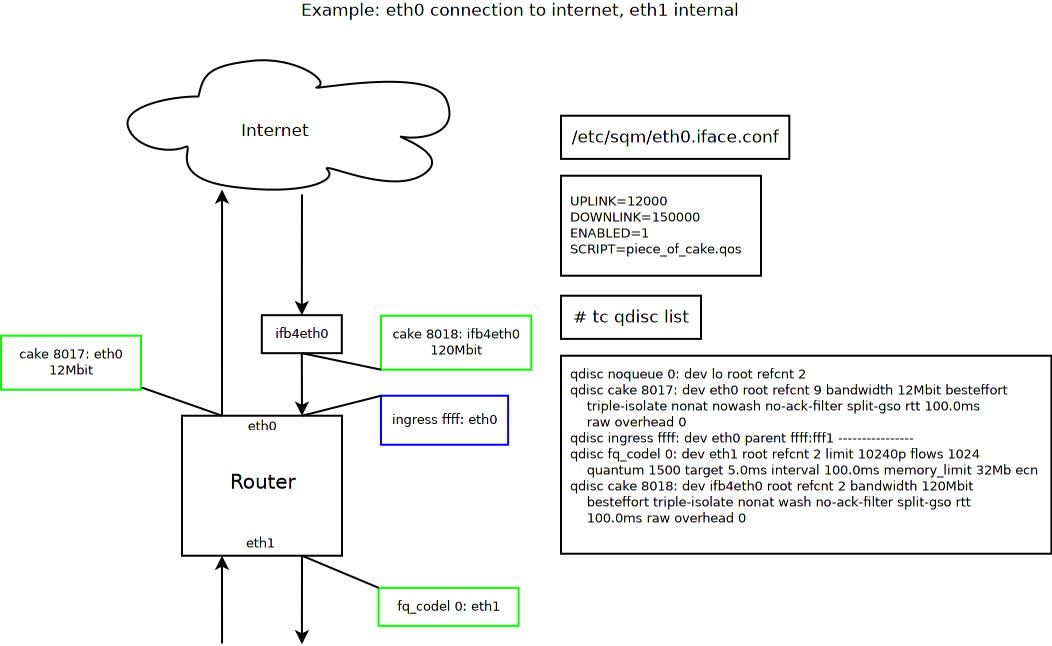|
|
3 tahun lalu | |
|---|---|---|
| platform | 3 tahun lalu | |
| src | 3 tahun lalu | |
| Makefile | 4 tahun lalu | |
| README.md | 4 tahun lalu | |
| qdisc-diagram.dia | 4 tahun lalu | |
| qdisc-diagram.png | 4 tahun lalu |
README.md
The sqm-scripts traffic shaper
This repository contains the sqm-scripts traffic shaper from the CeroWrt project. See: http://www.bufferbloat.net/projects/cerowrt/wiki/Smart_Queue_Management
How does sqm-scripts set up traffic shaping?
sqm-scripts uses the Linux qdisc mechanism to configure traffic shaping and scheduling. Either by a combination of the HTB qdisc (for shaping) and fq_codel (for packet scheduling), or using the CAKE integrated scheduler to do both at once.
Because qdiscs only see traffic as it is leaving an interface, for ingress shaping sqm-scripts sets up an IFB device. Incoming packets are redirected to this device where a regular qdisc can handle them. The IFB device is named for the egress interface it is paired with, so the IFB for 'eth0' will be called 'ifb4eth0'.
This is all illustrated on the following diagram:
 Diagram contributed by Matt Taggart (@taggart). Source in qdisc-diagram.dia.
Diagram contributed by Matt Taggart (@taggart). Source in qdisc-diagram.dia.
Requirements
To run sqm-scripts you just need a Linux machine with a kernel from the last
decade or so (any of the longterm releases on kernel.org should work - please
don't run a kernel that is not a currently released version, longterm or
current). The only exception is that if you want to use the cake qdisc, you
either need kernel 4.19 or newer (with matching iproute2 version), or you need
to build CAKE yourself from the out-of-tree repository at
https://github.com/dtaht/sch_cake.
Installing
sudo make install should install things on a regular Linux box. For
OpenWrt, there are packages available in the distribution, so just install the
sqm-scripts package, and optionally luci-app-sqm for GUI support.
Running on regular Linux distributions
After installing using make install, do the following to enable sqm-scripts:
Copy
/etc/sqm/default.confto/etc/sqm/<dev>.iface.confwhere<dev>is the name of the interface you wish to run sqm-scripts on. Then adjust the values in the file to your environment, setting at least UPLINK, DOWNLINK, and possibly SCRIPT.If you're on a Debian-derived distribution that uses old-style network config in
/etc/network/, the Makefile should detect this and drop in appropriate hotplug scripts, so sqm-script should automatically run on the next 'ifup'.If you're on a systemd-enabled distro, just enable the
sqm@<dev>service corresponding to your interface name. E.g., foreth0, issuesystemctl enable sqm@eth0(and runsystemctl start sqm@eth0to start sqm-scripts immediately).
"Installing" the current development version from git on OpenWrt
Run the steps below on your own computer (not on the router) to retrieve the newest script version from this repository, create the scripts, then copy those new scripts to your router.
Make a local clone of the git repository (if you have not already):
git clone https://github.com/tohojo/sqm-scriptsChange into the new directory:
cd ./sqm-scriptsMake sure the source is updated:
git pullCreate the scripts for your platform (PLATFORM is either linux or openwrt) and output them to a local
current_sqm_basedirectory:make install PLATFORM=openwrt DESTDIR=./current_sqm_baseChange to
./current_sqm_base:cd ./current_sqm_baseOptional for OpenWrt: The final step will overwrite your router's current sqm configuration file (at
/etc/config/sqm). If you want to preserve the current configuration, delete the newly created config file from the localetc/config:rm -r etc/configNow, use scp to copy the new scripts to the router. Change
$YOUR.SQM.HOSTNAMEto the address/DNS name for your computer - probably192.168.1.1or on cerowrtgw.hom.lan. If your account on the router is not "root", change "root" to your account:scp -r ./* root@$YOUR.SQM.HOSTNAME:/
Note this method relies on the presence of the required qdiscs on the router/destination host. On openwrt, you should first install the "normal" sqm-scripts package to take care of all the dependencies, then use this procedure to update to the newest sqm-scripts.
Run-time debugging
SQM_VERBOSITY_MAX controls the verbosity of sqm's output to the shell and syslog (0: no logging; 8: full debug output).
SQM_DEBUG controls whether sqm will log the output of the last invocation of start-sqm into var/run/sqm/${interface_name}.start-sqm.log and the ouput of the last invocation of stop-sqm into var/run/sqm/${interface_name}.stop-sqm.log e.g. for pppoe-wan /var/run/sqm/pppoe-wan.start-sqm.log and /var/run/sqm/pppoe-wan.stop-sqm.log.
Examples
Log only the binary invocations and their output:
/etc/init.d/sqm stop ; SQM_DEBUG=1 SQM_VERBOSITY_MAX=0 /etc/init.d/sqm startLog verbose debug output and all the binary invocations and their output:
/etc/init.d/sqm stop ; SQM_DEBUG=1 SQM_VERBOSITY_MAX=8 /etc/init.d/sqm startLog both start and stop:
SQM_DEBUG=1 SQM_VERBOSITY_MAX=8 /etc/init.d/sqm stop ; SQM_DEBUG=1 SQM_VERBOSITY_MAX=8 /etc/init.d/sqm start
Note: Both the start and stop log are re-written on every sqm instance start and stop and are logging all output independent of the value of SQM_VERBOSITY_MAX. They will not grow indefintely, but they are written repeatedly. On reliably rewritable media like hard disk, ssd, flash with wear-leveling, or ram-disk, SQM_DEBUG can be safely set to 1 in defaults.sh, but on media like NOR flash that do only allow few write-cycles, keeping the default at 0 and using the above invocations to run a single instance with SQM_DEBUG=1 is recommended.